filterbank
Syntax
Description
[
returns the spin-up and spin-down frequency wavelets, psifup,psifdown,phiffr,frequencymeta] = filterbank(jtfn,FilterBank="frequency")psifup and
psifdown respectively, the frequency lowpass filter
phiffr, and the metadata frequencymeta for the
frequency filters in the JTFS network.
The syntax filterbank(jtfn,FilterBank="time") is equivalent to
filterbank(jtfn).
Examples
Create a JTFS network with the energy correct filters option set to false. Specify quality factors of 9 and 2 for the first-order and second-order time wavelet filter banks, respectively.
jtfn = timeFrequencyScattering(EnergyCorrectFilters=false, ...
TimeQualityFactors=[9 2]);Obtain the filters in the first- and second-order time wavelet filter banks and their metadata. Plot the filters. Because the wavelets are analytic, their Fourier transforms are supported only on the positive real axis.
[psi1f,psi2f,phift,timemeta] = filterbank(jtfn); tiledlayout(2,1) nexttile plot(psi1f) grid on axis tight title("First-Order Time Wavelet Filter Bank") nexttile plot(psi2f) grid on axis tight title("Second-Order Time Wavelet Filter Bank")
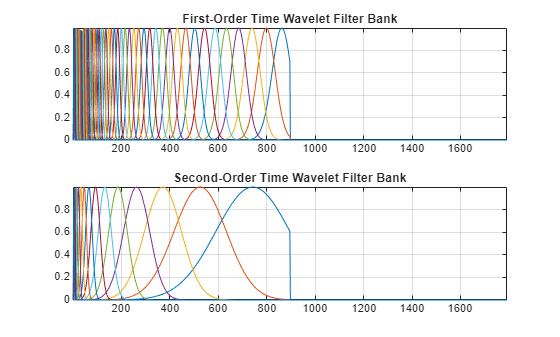
Inspect the size and metadata for the first-order time wavelet filter bank. The wavelet filters are arranged columnwise and in order of decreasing center frequency. The th table row describes the th filter.
size(psi1f)
ans = 1×2
1792 50
timemeta{1}ans=50×6 table
xi sigma isCQT log2dsfactor peakidx bwidx
_______ _________ _____ ____________ _______ __________
0.48076 0.022225 1 0 863 757 897
0.44512 0.020578 1 0 799 701 896
0.41212 0.019053 1 0 740 646 833
0.38158 0.01764 1 0 685 598 771
0.35329 0.016333 1 0 634 553 714
0.3271 0.015122 1 0 587 512 661
0.30286 0.014001 1 0 544 475 613
0.28041 0.012963 1 0 503 440 567
0.25962 0.012002 1 0 466 407 525
0.24038 0.011113 1 0 432 377 486
0.22256 0.010289 1 0 400 349 450
0.20606 0.0095263 1 1 370 324 417
0.19079 0.0088202 1 1 343 300 386
0.17665 0.0081664 1 1 318 278 358
0.16355 0.007561 1 1 294 257 331
0.15143 0.0070006 1 1 272 237 306
⋮
Choose a time filter bank. From its metadata, obtain the filter center frequencies and the logical values indicating if a center frequency is logarithmically spaced.
whichFB = 1;
centerFrq = timemeta{whichFB}.xi;
isCQT = timemeta{whichFB}.isCQT;Compute the ratios of consecutive center frequencies that are logarithmically spaced. Confirm the ratios are equal to , where is the quality factor of the filter bank.
qualityFactor = jtfn.TimeQualityFactors(whichFB); isLogSpaced = find(isCQT); cf = centerFrq(isLogSpaced); cfRatio = cf(2:end)./cf(1:end-1); [min(cfRatio) max(cfRatio) 2^(-1/qualityFactor)]
ans = 1×3
0.9259 0.9259 0.9259
Plot on a linear scale with a cross marker the center frequencies that are logarithmically spaced. Then plot with a circle marker the center frequencies that are linearly spaced.
figure plot(isLogSpaced,cf,'x-') hold on isNotLogSpaced = find(~isCQT); plot(isNotLogSpaced,centerFrq(isNotLogSpaced),'o-') hold off grid on legend("Logarithmically Spaced","Linearly Spaced") title("Time Wavelet Filter Bank Center Frequencies") ylabel("Frequency (cycles/sample)")
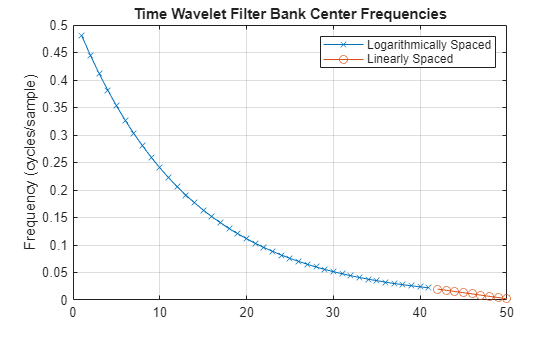
Make the same plot, but this time on a logarithmic scale.
figure semilogy(isLogSpaced,centerFrq(isLogSpaced),'x-') hold on semilogy(isNotLogSpaced,centerFrq(isNotLogSpaced),'o-') hold off grid on legend("Logarithmically Spaced","Linearly Spaced") title("Time Wavelet Filter Bank Center Frequencies") ylabel("Frequency (cycles/sample)")
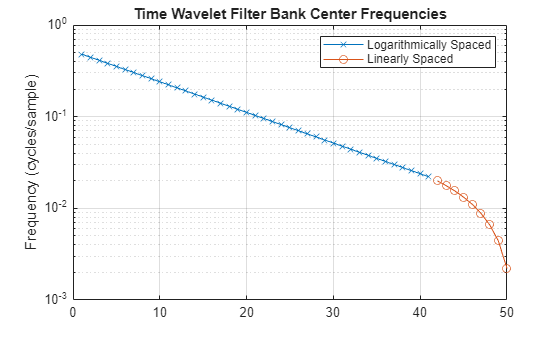
Create a JTFS network with the energy correct filters option set to false. Specify a frequency quality factor of 3.
jtfn = timeFrequencyScattering(EnergyCorrectFilters=false, ...
FrequencyQualityFactor=3)jtfn =
timeFrequencyScattering with properties:
SignalLength: 1024
NumFrequencyOctaves: 3
FrequencyInvarianceScale: 8
FrequencyQualityFactor: 3
TimeInvarianceScale: 128
TimeQualityFactors: [8 1]
TimeMaxPaddingFactor: 2
NumTimeOctaves: [7 7]
FilterDataType: 'double'
FrequencyMaxPaddingFactor: 2
EnergyCorrectFilters: 0
Obtain the spin-up and spin-down frequency wavelets and their metadata. Plot the wavelets.
[psifup,psifdown,phiffr,frequencymeta] = filterbank(jtfn, ... FilterBank="frequency"); tiledlayout(2,1) nexttile plot(psifup) grid on title("Spin-Up Frequency Wavelets") axis tight nexttile plot(psifdown) title("Spin-Down Frequency Wavelets") grid on axis tight
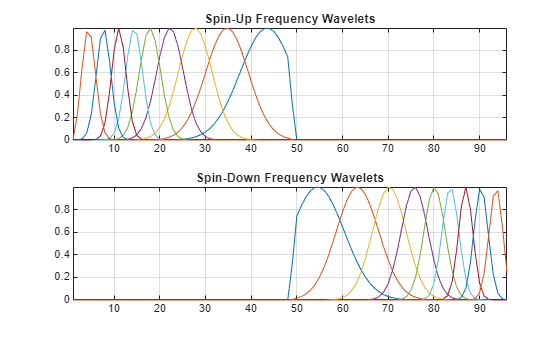
Inspect the metadata. The metadata is listed in order of decreasing center frequency, first for the spin-up wavelets, and then the spin-down wavelets.
frequencymeta
frequencymeta=18×7 table
xi sigma isCQT log2dsfactor spin peakidx bwidx
________ ________ _____ ____________ ____ _______ ________
0.44249 0.061128 1 0 1 43 28 49
0.35121 0.048518 1 0 1 35 22 47
0.27875 0.038508 1 0 1 28 18 38
0.22125 0.030564 1 0 1 22 14 30
0.1756 0.024259 1 1 1 18 12 24
0.13938 0.019254 1 1 1 14 10 19
0.10453 0.01625 0 1 1 11 7 15
0.069688 0.01625 0 2 1 8 4 12
0.034844 0.01625 0 2 1 4 2 8
-0.44249 0.061128 1 0 -1 55 49 70
-0.35121 0.048518 1 0 -1 63 51 76
-0.27875 0.038508 1 0 -1 70 60 80
-0.22125 0.030564 1 0 -1 76 68 84
-0.1756 0.024259 1 1 -1 80 74 86
-0.13938 0.019254 1 1 -1 84 79 88
-0.10453 0.01625 0 1 -1 87 83 91
⋮
Obtain the center quefrencies of the spin-up wavelets and the logical value indicating if a center quefrency is logarithmically spaced.
numRows = size(frequencymeta,1); centerQf = frequencymeta.xi(1:numRows/2); isCQT = frequencymeta.isCQT(1:numRows/2);
Compute the ratios of consecutive center quefrencies that are logarithmically spaced. Confirm the ratios are equal to , where is the quality factor of the filter bank.
qualityFactor = jtfn.FrequencyQualityFactor; isLogSpaced = find(isCQT); cf = centerQf(isLogSpaced); cfRatio = cf(2:end)./cf(1:end-1); [min(cfRatio) max(cfRatio) 2^(-1/qualityFactor)]
ans = 1×3
0.7937 0.7937 0.7937
By default, the number of frequency octaves is 3. Create a second network identical to the first, but instead set the number of frequency octaves to 2. Obtain the frequency wavelets and their metadata. Plot the spin-up and spin-down wavelets. The length and number of frequency wavelets is less than those in the original JTFS network.
jtfn2 = timeFrequencyScattering(EnergyCorrectFilters=false, ... FrequencyQualityFactor=3, ... NumFrequencyOctaves=2); [psifup2,psifdown2,~,frequencymeta2] = filterbank(jtfn2, ... FilterBank="frequency"); tiledlayout(2,1) nexttile plot(psifup2) grid on title("Spin-Up Frequency Wavelets") axis tight nexttile plot(psifdown2) title("Spin-Down Frequency Wavelets") grid on axis tight
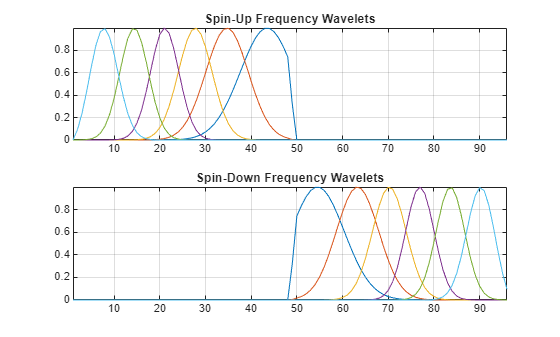
Input Arguments
Joint time-frequency scattering network, specified as a timeFrequencyScattering object.
Output Arguments
Time Wavelet Filter Banks
First-order time wavelet filter bank in the JTFS network, returned as a matrix. The wavelet filters are arranged columnwise and in order of decreasing center frequency.
Second-order time wavelet filter bank in the JTFS network, returned as a matrix. The wavelet filters are arranged columnwise and in order of decreasing center frequency.
Time lowpass filter in the JTFS network, returned as a vector.
Time filter bank metadata, returned as a two-element cell array. The ith element is a MATLAB® table that describes the ith-order time filter bank. Both tables have these variables:
xi— Wavelet center frequency (cycles/sample)sigma— Frequency standard deviationisCQT— Logical value indicating if center frequency is logarithmically spacedlog2dsfactor— Maximum downsampling factor on a base-2 logarithmic scalepeakidx— Center frequency location (one-based index)bwidx— Total bandwidth used to determine maximum downsampling factor
Frequency Filter Bank
Spin-up frequency wavelets in the JTFS network, returned as a matrix. The wavelet filters are arranged columnwise and in order of decreasing center quefrency.
Spin-down frequency wavelets in the JTFS network, returned as a matrix. The wavelet filters are arranged columnwise and in order of decreasing center quefrency.
Frequency lowpass filter in the JTFS network, returned as a vector.
Frequency wavelet metadata, returned as a MATLAB table with these variables:
xi— Wavelet center quefrency (cycles/octave)sigma— Quefrency standard deviationisCQT— Logical value indicating if center quefrency is logarithmically spacedlog2dsfactor— Maximum downsampling factor on a base-2 logarithmic scalespin— Spin-up (1) or spin-down (-1) waveletpeakidx— Center quefrency location (one-based index)bwidx— Total bandwidth used to determine maximum downsampling factor
Version History
Introduced in R2024b
See Also
Objects
Functions
MATLAB Command
You clicked a link that corresponds to this MATLAB command:
Run the command by entering it in the MATLAB Command Window. Web browsers do not support MATLAB commands.
选择网站
选择网站以获取翻译的可用内容,以及查看当地活动和优惠。根据您的位置,我们建议您选择:。
您也可以从以下列表中选择网站:
如何获得最佳网站性能
选择中国网站(中文或英文)以获得最佳网站性能。其他 MathWorks 国家/地区网站并未针对您所在位置的访问进行优化。
美洲
- América Latina (Español)
- Canada (English)
- United States (English)
欧洲
- Belgium (English)
- Denmark (English)
- Deutschland (Deutsch)
- España (Español)
- Finland (English)
- France (Français)
- Ireland (English)
- Italia (Italiano)
- Luxembourg (English)
- Netherlands (English)
- Norway (English)
- Österreich (Deutsch)
- Portugal (English)
- Sweden (English)
- Switzerland
- United Kingdom (English)